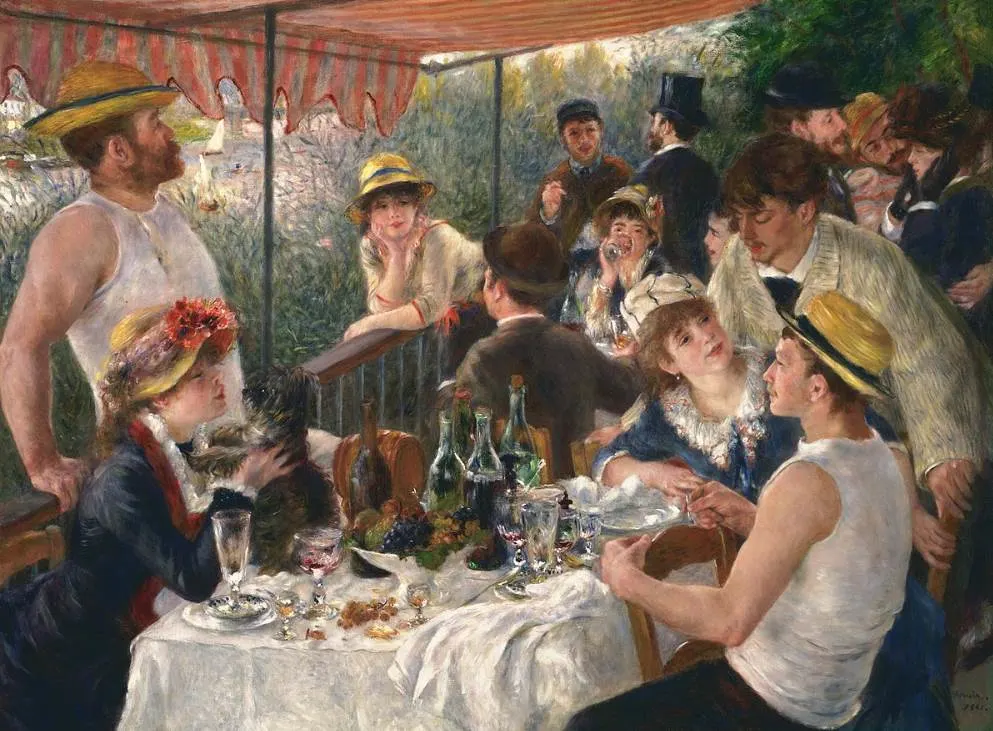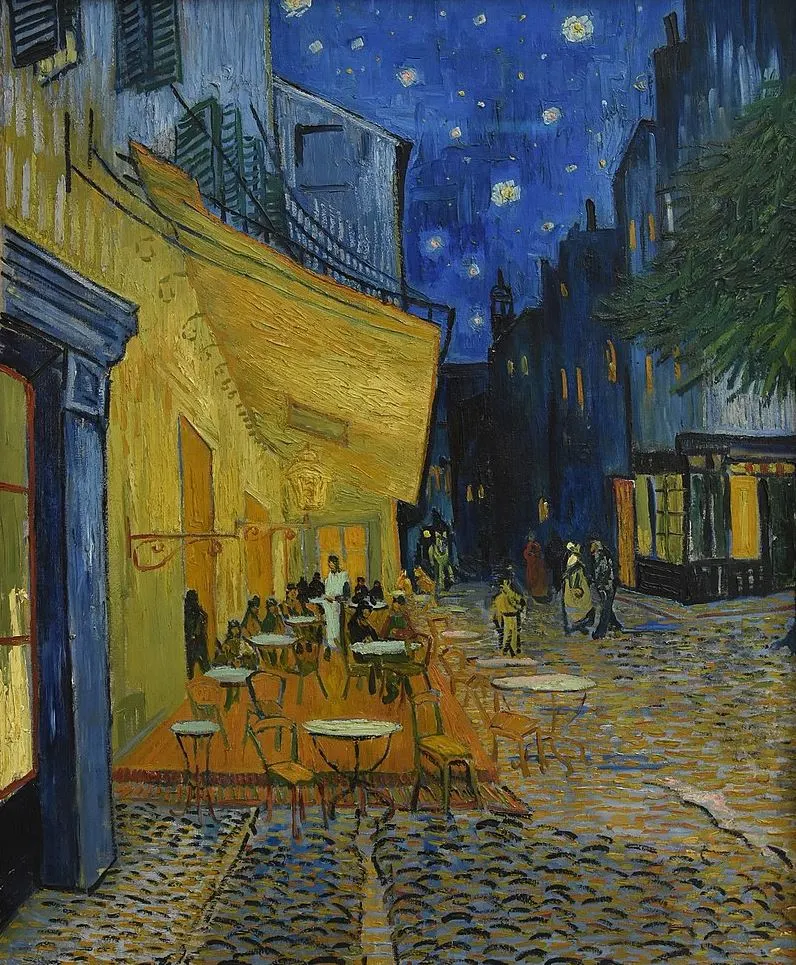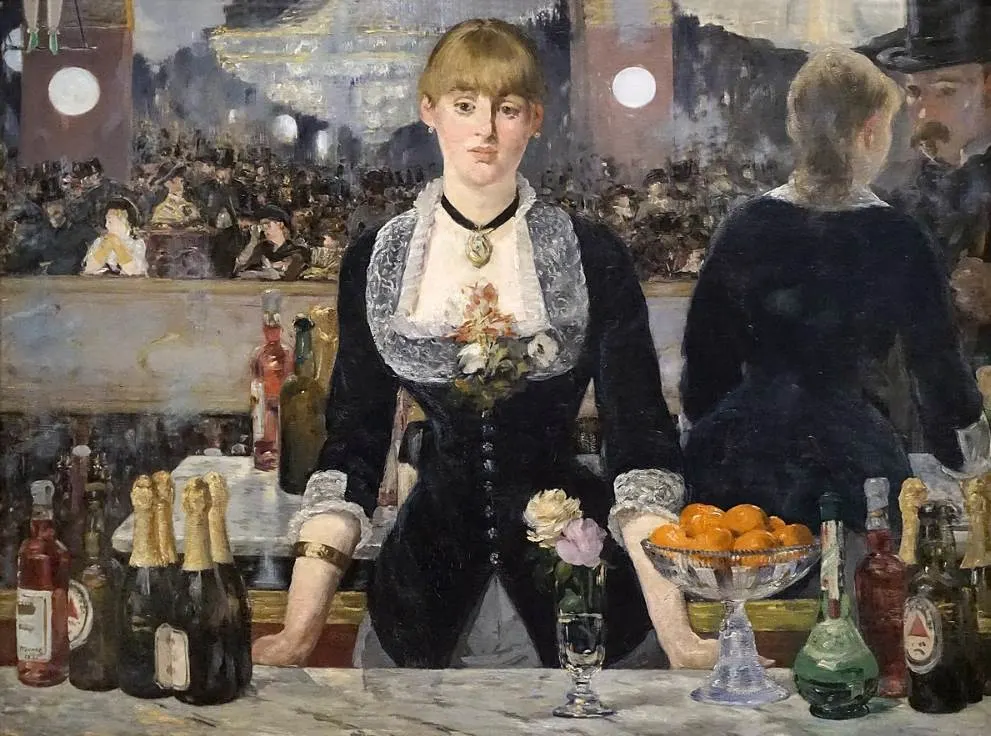It was only in the second half of the 19th century that the first artists who painted modern life emerged.
The Impressionist artists revolutionized the history of art by painting common subjects derived from real life in the modern world.
They often sought inspiration close to them and as they often met in cafes and restaurants, these establishments became the focus of their artistic endeavors.
The list below features some of the most famous Cafe paintings ever completed, and as you surely expected, these were painted in the 19th and 20th centuries.
1. The Night Café – Vincent van Gogh
- Date created: 1888
- Dimensions: 72.4 × 92.1 centimeters (28.5 × 36.3 inches)
- Location: Yale University Art Gallery, New Haven, United States
The Night Café is the title of one of the numerous masterpieces by Vincent van Gogh (1853-1890), the Dutch painter who developed a unique style during the Post-Impressionist era.
It depicts the interior of his favorite café in Arles, a town in southern France where he stayed at the time.
The painting features red walls, a green ceiling, and lights that appear to be vibrating. It’s a remarkable composition that defines his fascinating painting technique.
The title of the painting is a reference to the fact that these bars remained open all night, often welcoming guests who were too drunk to find refuge.

2. L’Absinthe – Edgard Degas
- Date created: 1875-1876
- Dimensions: 92 × 68 centimeters (36.2 × 26.8 inches)
- Location: Musée d’Orsay, Paris, France
L’Absinthe is the title of a painting by Edgard Degas (1834-1917) that was originally known as “Dans un Café” or “In a Café.”

It depicts a raw image of a man and woman who appear to be rather drunk and relatively miserable. The glass of absinthe in front of the woman probably explains why.
Even though the French artist was a well-respected painter at the time that he completed this work, it was severely mocked by contemporary critics in France.
It was only displayed again in England in 1893 and it didn’t win any hearts there as well, regardless of the fact that Degas merely painted a common scene in a bar.

3. The Café-Concert – Édouard Manet
- Date created: 1879
- Dimensions: 47.3 cm × 39.1 cm (18.6 in × 15.4 in)
- Location: Walters Art Museum, Baltimore, United States
The Café-Concert is the title of one of several café paintings by Édouard Manet (1832-1883), one of the first artists in history who painted modern life.
It shows the interior of a brasserie that was located at the southern foot of Montmartre, the hill and district in northern Paris where countless artists still hang out today.
The painting was completed during the final 5 years of the artist’s life and depicts a scene inside an establishment that provided entertainment.
A Café-Concert was quite lighthearted and less provocative than other types of cabaret. The painting is defined by women indulging in things that were considered to be of a lower level of morality at the time.

4. At the Moulin Rouge – Henri de Toulouse-Lautrec
- Date created: 1892-1895
- Dimensions: 123 × 140 centimeters (48 × 55 inches)
- Location: Art Institute of Chicago, Chicago, United States
At the Moulin Rouge is the title of a painting by Henri de Toulouse-Lautrec (1864-1901) that provides a rare glimpse inside the original Moulin Rouge, one of the most famous cabarets in the world.
Even though this cabaret still operates today, the original establishment burned down in 1915 and was only reopened several years later.
At the time that this painting was completed, the Moulin Rouge had only recently opened its doors in 1889.
Toulouse-Lautrec was a regular customer and also designed the posters to promote the new entertainment venue. He added his self-portrait in profile in the background (below the tall man wearing a hat).

5. Nighthawks – Edward Hopper
- Date created: 1942
- Dimensions: 84.1 × 152.4 centimeters (33.1 x 60 inches)
- Location: Art Institute of Chicago, Chicago, United States
Nighthawks is arguably one of the most famous paintings by Edward Hopper (1882-1967), a renowned American Realism artist.
Better yet, referring to this work as one of the most iconic paintings in American history isn’t really an exaggeration as well because it has been featured in a wide variety of media.
The painting depicts a brightly illuminated diner that is located in a rather dark and gloomy city environment.
The American artist never mentioned which diner inspired him except for a vague description of a place in Greenwich Village, New York City. He definitely took some liberties and made the establishment significantly larger than it really was.

6. Luncheon of the Boating Party – Pierre-Auguste Renoir
- Date created: 1881
- Dimensions: 129.9 × 172.7 centimeters (51 × 68 inches)
- Location: Phillips Collection, Washington D.C., United States
Luncheon of the Boating Party is the title of one of the most beautiful paintings by Pierre-Auguste Renoir (1841-1919), another French Impressionist artist who was highly influential in the late 19th century.
This work depicts a large group of people who enjoy lunch in a restaurant along the banks of the Seine River.
This place has been identified as the Maison Fournaise restaurant. This was located in Chatou, France, which is part of the western suburbs of the metropolitan area of Paris today.
The owner of the establishment is the prominent figure on the left and the other people are Renoir’s friends and colleagues. These include his future wife Aline Charigot (below the owner) and fellow painter Gustave Caillebotte (bottom right).

7. Café Terrace at Night – Vincent van Gogh
- Date created: 1888
- Dimensions: 80.7 × 65.3 centimeters (31.8 × 25.7 inches)
- Location: Kröller-Müller Museum, Otterlo, Netherlands
Café Terrace at Night is the title of another painting by Vincent van Gogh that he completed while he was staying in Arles in the year 1888.
The painting is also known as “The Cafe Terrace on the Place du Forum,” a reference to the square in Arles where this establishment is located.
I say “is located” because this café still exists today. To make things even more fascinating, there’s a plaque in the northeastern corner of the square that marks the place where van Gogh set up his easel.
Another remarkable fact about this painting is that it features the same starry night as in his iconic paintings “The Starry Night” and “Starry Night over the Rhône.”

8. Bal du Moulin de la Galette – Pierre-Auguste Renoir
- Date created: 1876
- Dimensions: 131 × 175 centimeters (52 × 69 inches)
- Location: Musée d’Orsay, Paris, France
Bal du Moulin de la Galette or “Dance at Le moulin de la Galette” is another enthralling painting by Pierre-Auguste Renoir.
This amazing work of art is considered to be one of the most iconic Impressionist paintings ever completed and depicts the scene at an establishment called the Moulin de la Galette.
This place was located in the Montmartre district and was usually bustling with people every Sunday afternoon, something that is perfectly reflected in this painting.
This painting was owned by Renoir’s colleague and friend Gustave Caillebotte, the man he included in his other famous café painting titled “Luncheon of the Boating Party.”

9. Night Café, Arles – Paul Gauguin
- Date created: 1888
- Dimensions: 73 x 92 centimeters (28.7 x 36.2 inches)
- Location: Pushkin Museum, Moscow, Russia
Night Café, Arles is the title of a painting by Paul Gauguin, the French artist who visited Vincent van Gogh in Arles in the final months of 1888.
The painting depicts the interior of the same establishment as we could see in van Gogh’s café painting and he also included the owner of the place, Madame Ginoux.
He also included the billiard in the center and tables with customers. The desperate drunkards are on the left and the people socializing sit at a table next to them.

10. A Bar at the Folies-Bergère – Édouard Manet
- Date created: 1882
- Dimensions: 96 × 130 centimeters (37.8 × 51.2 inches)
- Location: Courtauld Gallery, London, United Kingdom
A Bar at the Folies-Bergère is the title of the final major painting completed by Édouard Manet, the influential French artist who died less than two years later.
It’s a rather complex painting that allows us to look behind the bar of the Folies Bergère nightclub in Paris. The mirror on the wall allows us to see inside the establishment.
Even though it’s clear that there’s a mirror behind the woman, the reflection in the mirror doesn’t appear to be realistic.
Research has shown that the painting is actually accurate because she is engaged with a customer to her left, somebody whose outside our viewing point.

